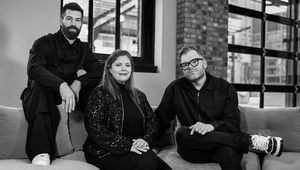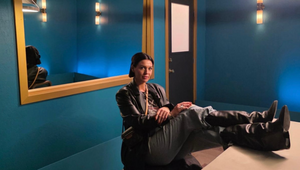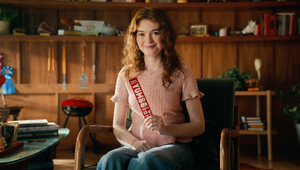
How NewYork-Presbyterian Is Helping New York ‘Stay Amazing’

Continuing with the ‘Stay Amazing’ platform, Havas New York teamed up once again with NewYork-Presbyterian Hospital to tell the raw and unfiltered stories of four patients from New York. Positioning the hospital as a performance-fueled consumer brand, the films use patient-owned footage, approved medical documentations and a variety of different mediums - including animation and docu-style videography - to reveal the patients’ visceral stories.
The films pay homage to the next-level care that is delivered by NewYork-Presbyterian (NYP) as well as the heart and determination of the patients at the centre of these remarkable tales. The films follow Tracy, a cancer survivor; Gabby, a powerful softball player who received complex treatment for a miraculous spinal curvature operation; Peter, a firefighter who had an extraordinary heart-transplant; and Suri, a child and aspiring fashion designer who underwent paediatric heart treatment.
As well as premiering at the US Open, the campaign has partnerships with The World Cup, NFL and MLB, a robust digital strategy and primetime TV slots that share the stories of medical excellence and human perseverance with a wide range of people.
To go behind the scenes on this campaign, LBB’s Ben Conway spoke to NewYork-Presbyterian’s chief marketing and communications officer, Devika Mathrani, Havas’ Global ECD and MD, Israel Garber, and Havas’ CCO, Dan Lucey.
LBB> Where did the initial creative spark for this campaign come from? What was the new direction/concept behind this continuation of the ‘Stay Amazing’ campaign?
Devika> When I started as chief marketing and communications officer for NYP last summer, one of the first things I did was look at the hospital system’s brand marketing efforts - coming from a different angle with 20+ years of marketing experience in the financial services space. What became clear was that, while the creative and messaging was powerful, we were talking to and about ourselves as opposed to the customer. We needed to make the customer our primary focal point, to show them that we are their partner of choice for their wellness journey and to help them feel empowered about their health.
There was also a need for our brand identity and architecture to more clearly explain the breadth of the NYP system. ‘Stay Amazing’ builds on the brand’s previous positioning while modernising it to celebrate the consumer aspiration and outcome. It’s a performative and vibrant platform to tell our patient stories that range from every day to extraordinary care, highlight the expertise of our physicians and front-line teams and share our content and expertise to be a part of consumer’s everyday lives.
Dan> Havas started working with NYP officially last September after a competitive pitch. Devika and the entire NYP team have been tremendous clients ever since. We see ourselves as an extension of their organisation and take pride in having the ability to work fast, producing hundreds of assets each month. You can only do that if there's trust and true partnership.
We had endless examples of how the world-class doctors at NYP ensure their patient’s health stays amazing. We knew we needed to tell these stories and use a creative vehicle to get them out into the world. We saw that each patient and doctor had their own relationship, so each film is quite different. Our aim, from the start, was always to retell their stories in the most authentic way possible.
LBB> What are some factors affecting the target audience of this campaign right now? And how have they influenced the campaign and branding?
Devika> The reality is that we are two years into one of the worst public health crises of our lifetime and this pandemic has not only taken the lives of millions of people around the world, but it has also exposed so many issues connected to health and health equity. As we look to the future, we must continue to transform how care is delivered, to make it more convenient, accessible, and equitable for all. What people need from their health care providers has changed, consumers’ engagement with their health has become more proactive and their expectations of the experience is elevated. This campaign represents how we are evolving to meet our patients’ needs and delivering exceptional care - a combination of the best of technology and humanity wherever and whenever our patients need it.

LBB> For lots of us outside the US, marketing a healthcare service like this is a somewhat foreign concept. How does a healthcare service such as NYP work with agencies like Havas to position itself as a “performance-fueled consumer brand”?
Devika> The industry is more commercial than it’s ever been and with the number of marketing channels that exist today, consumers are being exposed to so many options at any given time. Choosing a healthcare provider is no longer based on which hospital happens to be located closest to your home or the referral your primary care doctor gave you. Consumers care about the entire experience and have access to research and reviews to make an informed decision. We want consumers to connect with us on a more real and emotional level. When you see a Nike ad, you get excited about what the brand stands for and its energy – we want consumers to feel the same way when thinking about their wellness partner.
Israel> If you have a hospital as a client, it’s human nature to focus on the hospital’s contribution to a person’s health, typically shown as grand shots of medical equipment and people in beds hooked up with doctors and nurses reviewing charts. It’s very inward gazing. However, the best proof of a hospital’s care is in the outcome of the patient. In this sense, we challenged ourselves by flipping the emphasis.
LBB> Who discovered the three patients and their stories? What was the process like of finding and choosing which stories to feature?
Israel> We gave the NYP team a very focused criteria that narrowed the pool down tremendously. We looked for people who had unique interests or vocations, specifically people who excelled at that endeavour. Not everyone is a firefighter or a Division 1 softball star, like Peter and Gabby. For Suri, we found her interest in fashion from a Zoom interview. When a nine-year-old girl tells you she likes to sketch fashion and her favourite designer is DIOR we knew we had something unique. All in all, there is a dimension of authenticity that we search for and a visually engaging potential to each story.
Devika> There is no shortage of unbelievable patient stories to share. We are always engaging with our incredible physicians and they are always letting us know about stories that are taking place. When we review the stories shared, we look for diversity across service lines (cardiology, paediatrics, transplant, orthopaedics, etc.), patients who represent different ages, genders, races, and ethnicities, and stories that will telegraph well on film, digital and print. We will only feature real patients in our creative and we get to know every patient personally to make sure they’re comfortable telling their unique stories and to ensure we tell the story in a way that is authentic and accurate to them.
LBB> The three films each have their own feel - Gabby’s is very personal with lots of family pictures and footage, Peter’s is more like a traditional documentary, and Suri’s uses animation. What went into these decisions?
Israel> Our goal is to give each story the production nuances it needs to enhance the humanity and emotional punch. As we conducted our interviews and then reconnected as a writing team, we all started to feel a pull to a sensibility.
For Peter - from his stories of firefighting and brotherhood, we knew immediately we wanted a docu-style action film. For Gabby - Elle Ginter has such a gift to get into the head of a female athlete, so we wanted her take on Gabby. For Suri - we realised early on that her dream to be a fashion designer may be best served by creating a dreamlike world all instigated by her sketchbook. While animation may seem like a departure from the live action work, it helped this story land its heart.
LBB> Do you have a favourite sequence, moment or aspect of the films?
Devika> The spot with Peter and Dr. Uriel was incredibly special because we were able to authentically experience and capture the relationships that played a critical role in Peter’s story. Firstly, the love and care that exists between Peter and the other firefighters in his firehouse is so genuine - they are truly his family and were with him every moment of his care. Secondly, the relationship between Peter and Dr. Uriel is special - they are two gentlemen who have committed their lives to taking care of people in their professions and that mutual respect and living this healthcare experience together has created an incredible bond, trust, and friendship.
Another favourite moment was filming with Gabby, the 14-year-old who had spinal fusion surgery to correct a 69-degree curve in her spine and is now an NCAA college softball player. Getting to film on the field with her and some teammates allowed us to personally experience and capture the joy that Dr. Lenke and the team at Och Spine were able to make a reality for a young woman who thought her dreams of being an athlete were over. Gabby smiles infectiously on the field – and knowing NewYork-Presbyterian enabled that smile made that a great moment to film.
Israel> In Peter’s story, we had to get across the fact that he first went to a New Jersey Hospital before he went to NYP. So, we came to the idea of an ambulance racing across the George Washington bridge. Logistically a challenge, but our directors welcomed the dare. With a well-timed drone and a small window for twilight, we captured this cinematic shot of a firefighter being rushed to the highest level of care around. It’s less than three seconds but the scale and emotional context of the shot make a huge difference in the impact of the film.
In Tracy’s story there are several very powerful moments. Some introspective, like when she sits on the bus staring out the window. Others are hopeful, like when she connects with family in her karaoke scene. But it’s when we reveal her at the end in her pink cap and matching sweatsuit, that we see a cancer patient become a superwoman. Tracy’s energy in that scene is 100% authentic. All wrapped up in this purposeful pink ensemble, no different than a superhero’s transformation into a saviour.
We leveraged two very key truths. Lean into the legendary resilience of the people who call this geography home and match the world-class doctors of NYP with world-class stories. Our doctors are like world-class athletes and our patients are people who give it their all and have an air of excellence at their core. That, housed in the muscular filmmaking and editorial style, result in a series of films that slant to performance brand. The closing graphic badge of ‘STAY AMAZING’ in the GT AMERICA font is also a conscious decision to mimic the energy of a performance brand.
LBB> Are there any restrictions or things to consider when developing a healthcare brand/campaign?
Devika> Healthcare is a sensitive topic - it’s very personal and not a topic many people like to talk about. It can be scary and intimidating and often avoided. It’s also a highly regulated category with HIPAA so we are always very careful and compliant about how we market. How you market your expertise, position the brand, and tell a story needs to be done with great care, consideration, and an unwavering attention to detail. You also need to have a conversation with consumers and not talk at them - consumers want to understand what to expect in healthcare so visuals, descriptions and sharing the experience is very important and impactful.
LBB> Were you on set for any of the shoots? How was that process?
Devika> Yes, I was on set for many of the shoots – which is really the most fun part! What I’ve learned is that you have to be able to find different ways to capture medical brilliance in 30 and 60 seconds, and there’s really no formulaic answer to doing that. These stories must also be told authentically through the eyes of the patient and/or physician to capture each person’s essence and experience correctly. We use their words, their emotions, and apply visual treatments to bring the medical components to life. I’ve never done anything quite like this before.
Israel> What was most eye-opening was the prep work done before we got to set. We arranged Zoom calls with each patient and allowed them to tell their stories to us, raw and unfiltered. In some, there were tears and moments of real pain, but each person closed our interviews composed and truly changed by what they experienced with NYP.
The dialogue in the interviews was gold. Although we had scripted each patient's story with the utmost care for moving the story forward, we were able to source more compelling pieces that elevated the scenes we chose to form the edit. A lesson learned is the invaluable amount of texture you can source from simply letting your subjects tell their story unscripted with all the pauses and asides.
LBB> What was the hardest challenge you faced on this campaign - and how did you overcome it?
Devika> The hardest challenge comes back to telling a story that creates an emotional connection with consumers and clearly communicates what type of expertise and services we can provide them in a very short amount of time. And, also translates the story from film to print, digital, radio, social and out-of-home. Healthcare, medical conditions, these stories are very personal and can be very complicated. Our goal is to make them as authentic and genuine as possible.
Israel> We had a thesis going into this campaign: we could shift the typical hospital patient story to something that more resembled a performance brand. We all agreed we had to raise the energy of the brand and elevate the overall takeaway of thriving. We asked the client to go along for this ride and together we’d get there. Our choice of directors was an immediate push outside the category into the world of sports. Once we got past the love for the humanity and the energy for the first film, we had the collective confidence to see through our vision.












